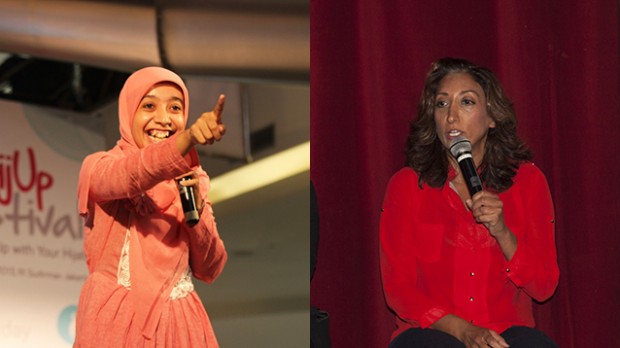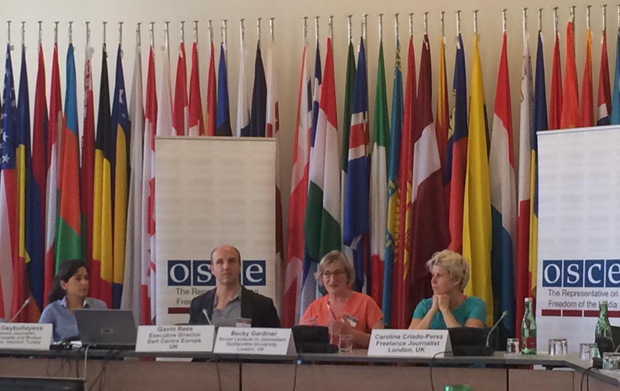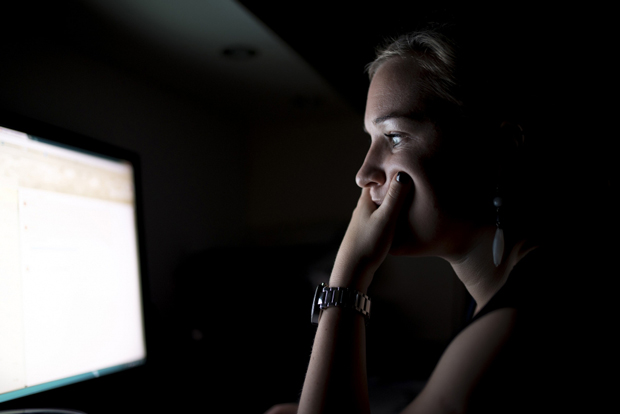12 Apr 2016 | Awards, mobile
Indonesian comedian Sakdiyah Ma’ruf, a nominee for the 2016 Index on Censorship Freedom of Expression Award for arts, was born to conservative Muslim family in Java and went on to become one of very few female stand-up comedians in the country to appear on national TV.
British comedian Shazia Mirza, the host of this year’s awards, talks to her about tackling no-go subjects, trying to win family approval, and how the stand-up scene is growing for women in Indonesia.

Sakdiyah Ma’ruf (left) and Shazia Mirza (right)
SHAZIA: Have your parents come to watch you do stand-up?
SAKDIYAH: My parents came to one of my shows once. It was in 2012 in one of the biggest theatres in Jakarta. I invited them to the show because it was held in a “dignified” building. I wanted to help my parents, and especially my dad, see that I was doing a “dignified” job.
I was very nervous. It was a full house. But I didn’t care whether the audience liked me or not, as long as I could get at least silent approval from my dad.
Since the show, my dad has supported me in my career as a comedian – not fully perhaps – but from this moment on, he knew that stand-up was something I did and would continue to do – in addition to the other “real jobs” I have.
I remember my parents saying they were pretty nervous about how the audience would respond to me. Perhaps my dad thought he could accept what I was doing if I gained approval from at least half of the audience.
The truth is that it isn’t always easy to get out of the house to perform. In June 2015 I was invited to open for a good friend of mine who is one of the biggest stand-up comics in Indonesia. He called me in April for the gig and it took me almost a month just to craft the right sentence to ask for my dad’s permission to perform.
SHAZIA: Do you say exactly what you want to? Or do you think: “No I can’t say that, people might get upset”
SAKDIYAH: The truth is that I rarely say exactly what I want to. I mean, can you imagine expressing all those voices in your head to the audience?
I say what I believe in; what I have experienced; what I am concerned about; what I like; what I don’t like; what I’m angry about… For me, comedy is always about telling the truth. You can’t be genuinely funny without being completely honest with yourself and your audience.
But I do self-censor, I self-censor all the time! I’m not afraid to talk about taboo topics like religion, race relation, a bit of sex etc – but only if it helps me to be honest with myself and my audience to be honest with themselves. I make sure I craft my jokes on these topics in a way that is truly funny; otherwise I’ll just sound like another girl complaining about how unfair life is.
I also make sure I’m being fair. I fact-check before I talk about something, so that I don’t just make things worse.
SHAZIA: Are you the only woman in Indonesia doing stand-up?
SAKDIYAH: No, of course not. I was the first, but the number is now growing. Every year there are new female stand-up comics performing on TV or participating in competitions.
SHAZIA: Do you feel pressure to talk about “heavy” subjects, like Islamophobia and terrorism, in your comedy? Or do you prefer to talk about lighter things sometimes – like shopping, dating, going on holidays.
SAKDIYAH: I want to talk about the issues that matter to me, things I can relate to, things that are part of who I am and what I have experienced.
I love talking about Muslims and the way they practice and interpret their religion. I talk about Islamophobia, violence towards women, the idea and construction of femininity and masculinity, my ethnicity.
Yeah, sometimes I feel such pressure to talk about “heavy” topics, but for what it’s worth, I think there is no such thing as a “light” topic in comedy. With a great comedian, even jokes about a refrigerator can bring new insights on humanity.
And I guess this is what is so beautiful about comedy: it helps us get to know who we are who others are as well. Every individual has multiple identities. I have been perceived as this Muslim girl fighting against fundamentalism through her comedy. While this is true, I do not want to just be seen as some kind of a “comedy jihadist” fighting against fundamentalists. I have layers to my identity, just like everybody else.
SHAZIA: Do you receive letters and emails from people who have seen your performances? What kind of things do they say? What do women say?
SAKDIYAH: Yes, I do. A woman once asked me whether I am a “true” Muslim. Perhaps she considered my jokes too daring or inappropriate for a Muslim woman to tell. She asked me all these questions about whether I really wear the hijab every day and whether I pray five times a day.
I like getting these kinds of responses. I feel like these people genuinely care about me or at least about Muslim women in general.
22 Sep 2015 | Austria, mobile, News and features, United Kingdom

Panelists at the OSCE meet on online attacks against journalists: writer Arzu Geybulla; Gavin Rees, Europe director of the Dart Center for journalism and trauma; Becky Gardiner, from Goldsmiths, University of London; journalist Caroline Criado Perez
“This is not something that only ‘ladies’ can fix,” emphasised Dunja Mijatovic, the OSCE’s Representative on Freedom of the Media at an expert meeting on the safety of female journalists in Vienna on 17 September 2015, which Index on Censorship attended.
The importance of collectively tackling the growing problem became an overarching theme of the conference. “There is a new and alarming trend for women journalists and bloggers to be singled out for online harassment,” said Mijatovic, while highlighting the importance of media, state and NGO voices coming together to address the abuse.
Arzu Geybulla and Caroline Criado Perez, journalists from Azerbaijan and the UK respectively, started the meeting with moving testaments of their own experiences. Despite covering very different topics, they have received shockingly similar threats – sexual, violent and personal. “Shut your mouth or I’ll shut it for you and choke you with my dick” was one of the messages received by Perez after she campaigned for a woman to feature on British banknotes.
Although male journalists also receive abuse, women experience a two-fold attack, including the gendered threats. Think tank Demos has estimated that female journalists experience roughly three times as many abusive comments as their male counterparts on Twitter.
The problem, said Perez, was not just the threats but how the women who receive them are then treated. “Women are accused of being mad or attention seeking, which are all ways of delegitimising women’s speech,” she said. “People told me to stop, close my Twitter account, go offline. But why is the solution to shut up?” She added: “This is a societal problem, not an internet problem.”
“Labelling a person, and making that person an object, is particularly common in Azerbaijan,” said Geybulla, an Azeri journalist and Index on Censorship magazine contributor who was labelled a traitor and viciously targeted online after writing for a Turkish-Armenian newspaper. “Our society is not ready to speak out. You can’t go to the police. The police think it must be your fault.”
The intention of the meeting was to highlight the problem, while also proposing courses of actions. Suggestions included calls for more education in digital literacy; more training for police; more support from editors and media organisations, and from male colleagues. There was some disagreement on whether the laws were robust enough as they stand, or needed an update for the internet age.
Becky Gardiner, formerly editor of Guardian’s Comment is Free section, spoke about how her own views on dealing with online abuse had changed, having initially told writers they should develop a thicker skin. “It is not enough to tell people to get tough. Disarming the comments is not a solution either. That genie is out of the bottle.” Gardiner, who is now a lecturer at Goldsmiths, University of London, is working on research into the issue, as commissioned by the Guardian’s new editor, Kath Viner.
It was suggested that small but crucial steps could be taken by media organisations to avoid inflammatory and misleading headlines (which are not written by the journalist, but put them in the firing line) and to be careful of exposing inexperienced writers without preparation or support. Sarah Jeong from Vice’s Motherboard plaform said, in her experience, freelancers often came the most under attack because they don’t have institutional backing.
The OSCE said this will be the first in a series of meetings, with the aim of getting more organisations to take it serious and to produce more concrete courses of action.
Read more about the online abuse of women in the latest issue of Index on Censorship magazine, with a personal account by Gamergate target Brianna Wu and a legal overview by Greg Lukianoff, president of the Foundation for Individual Rights in Education (Fire).
Tweets from OSCE’s #FemJournoSafe conference:
https://twitter.com/julieposetti/status/644456066432937984
27 Aug 2015 | Europe and Central Asia, mobile, News and features

Female journalists and bloggers are increasingly being singled out and fiercely attacked online. (Photo: OSCE)
In a new online column for Index on Censorship, Dunja Mijatović, OSCE Representative on Freedom of the Media, discusses relentless attacks on women journalists, and the impact on their lives.
No job comes without sacrifices, but how many downgrading comments, criticism or even threats can one person take before it becomes too much?
Just consider the experiences of a female journalist that I know:
She had her phone number shared on dating websites, her email and other accounts were hacked, she received death threats on Skype, the website publishing her articles was hacked and a sex video was posted with the implication that she had participated in an orgy. Anonymous articles with lies about her and her family were also posted online.
Imagine being forced to shut down your accounts on social media platforms because of such massive attacks with detailed images of rape and other forms of sexual violence.
At one point, you would probably be inclined to ask yourself if it is really worth it. Is this a career I want to continue to pursue?
In the past few years, more and more female journalists and bloggers have been forced to question their profession. Male journalists are also subject to hate speech and online abuse, but research findings suggest that female journalists face a disproportionate amount of gender-based threats and harassment on the internet. They are experiencing what Irina Bokova, director-general of UNESCO, has described as a “double attack”: they are being targeted for being both a journalist and a woman.
How do these attacks affect female journalists’ lives, their work and society in general? Journalists are used to being in the frontline of conflict and they often deal with difficult and even dangerous situations. But what if you cannot shield yourself from these threats? What if the frontline became your own doorstep, your office or your computer screen?
Not only do these kinds of attacks cause severe physiological trauma for journalists and their families, but by constantly being singled out and targeted with abusive comments, many female journalists may re-evaluate the issues they choose to cover. In this way, such attacks pose a clear and present threat to free media and the society as a whole.
Online abuse must be dealt with within the existing human rights framework, with governments committed to protecting journalists’ safety and addressing gender discrimination. Governments must ensure that law enforcement agencies understand the severity of this issue and are equipped with the necessary training and tools to more efficiently investigate and prosecute online threats and abuse.
We have to acknowledge that online threats are as real and unacceptable as threats posed in the offline world. The landmark resolution 20/8 on internet freedom adopted by United Nations Human Rights Council in 2012, affirmed that “the same rights that people have offline must also be protected online, in particular freedom of expression”, and set out a clear path in this respect.
The responsibility to counter online abuse of female journalists does not solely rest with law enforcement agencies, however. The broader media community itself also plays an important role. One of the challenges facing media outlets is how to improve quality of content moderation without invoking censorship.
Sarah Jeong, lawyer, journalist and author of The Internet of Garbage, provides proper context, “moderation paradoxically increases the number of voices heard, because some kinds of speech chills other speech. The need for moderation is sometimes oppositional to free speech, but sometimes moderation aids and delivers more free speech”.
Media outlets need to address the current structures and strategies in place that provide support and relief to journalists who face online abuse. A recent survey of female journalists in the OSCE region carried out by my office suggests that employers’ awareness and active involvement in dealing with these issues is of crucial importance. Unfortunately, the survey also indicated that media outlets are not as involved as they should be.
International organisations should also dedicate resources to tackle this issue, given their widespread reach and vast partnership networks. UNESCO’s work on gender-related aspects of journalists’ safety serves as a good example. In their recent report Building Digital Safety for Journalists, online abuse of female journalists was rightly pointed out as one of the main challenges in building digital safety.
This year I have tried to use my mandate and tools given to me as the OSCE Representative on Freedom of the Media to get the OSCE participating states involved. We need to realize that different stakeholders face different challenges, but that each stakeholder’s involvement is a crucial piece of the puzzle in identifying solutions.
To further the discussion on protection of female journalists in the OSCE region, on 17 September my office will host a conference, New Challenges to Freedom of Expression: Countering Online Abuse of Female Journalists, to provide a platform for discussions on best practices and recommendations on combating this dangerous trend. The event will be streamed live on osce.org and will feature presentations by high-level experts from all over the world.
This column was posted on 27 August 2015 at indexoncensorship.org
15 Apr 2014 | Academic Freedom, News and features, Religion and Culture, United Kingdom, Young Writers / Artists Programme

(Photo: Shutterstock)
At the University of Bristol the stagnating number of female academics in multiple degree subjects has become an increasingly important and concerning issue. Over 65.4% of Bristol students, according to my March 2014 survey, perceived a noticeable imbalance of female to male lecturers. I agree. My research led me towards an obvious concern for Bristol students: gender inequality of academia in all subjects.
With The Independent reporting that 63.9% of female undergraduates are leaving universities with “good” degrees, a lack of visibility of female academics at the University of Bristol — especially in the more scientific faculties — is in stark contrast to the number of undergraduates in the same subjects. More and more articles are appearing asking “Where are the men?” seeking to discover why the gender gap of undergraduates is weighted in women’s favour, but few have even commented on the fact that women are still struggling for visibility as academics. Women are avoiding the academic world and important questions must be asked about whether this is evidence of institutional laziness on the part of universities.
A recent Commons Report titled “Women in Scientific Careers” (focussing solely on the topic of academia) found the gender diversity – or lack of it – in senior academic positions in STEM (Science, Technology, Engineering and Mathematics) “astonishing”. This conclusion of surprise is certainly supported by the Bristol experience: only 19% female Biology academics and fewer than 7% female Chemistry academics. Science students are beginning to question the gender gap at an academic level and why in 2014 it still remains an issue for women to break into STEM academia. One biology student commented: “I’m in my second term of University and I’ve yet to be taught by a woman. Representation is important and it’s worrying that female undergraduates might be less inclined to pursue an academic career.”
Universities are attempting to improve the imbalance in STEM departments with processes such as the Athena Swan awards. However, the School of Chemistry at Bristol holds a Bronze award for “promoting gender equality” despite having fewer than ten female academics in one of the largest departments at Bristol. The bar seems quite low. This doesn’t mean there isn’t a tangible appetite to tackle inequality in academia head on, it just seems that there has been little visible progression, simply supplementary reports and promises to improve.
Many female academics such as Athene Donald, professor of experimental physics at the University of Cambridge, have expressed disappointment with the Commons Report mostly due to it appearing to provide nothing more than “superficial recommendations”. I agree with Donald when she suggests more “drastic action” to tackle the current gender norms in university departments, without a vocal and aggressive protest calling for more inclusive hiring strategies. “There is a long, long way to go but all parts of the system need to be addressed if we are going to get past the stage of mere astonishment,” Donald wrote in February. We need to involve all levels of education; if women aren’t being encouraged equally at all stages of schooling then fixing the top level of academia will do little to fix the imbalance.
Personally, it’s been my experience with the history department at Bristol that has sparked this article. Why in a subject such as history with an equal amount of male and female undergraduates are there only 29% female academic staff? Having so few women lecturers in history when both genders are so equally matched at undergraduate level causes students to wonder if the higher jobs remain a boys’ club even in 2014.
Lynne H. Walling, head of pure mathematics at University of Bristol, has experienced more than her fair of sexism on her route to the top of her profession. Maths stereotypically has always been seen as a masculine pursuit and women have often been excluded or stymied in their interest. “More and more women do math, but we can hardly find female mathematicians who keep on researching the field.” She commented in interview with Somin Kim: “Only a few speakers at academic conferences are women, and sometimes none. Women feel that they don’t fit in the mathematical society and this is the hardship to continue their research.” Representation has always been a core issue. Without at least an approximation of gender equality among lecturers, female students are less like to dream to achieve. There isn’t an absence of female curiosity or intellect, there’s a lack of a platform.
But does a mismatch between women students and male lecturers actually impact free expression? At an undergraduate level the gender of their tutor seems to greatly impact female students. It becomes an issue of their future career as many women are told by those in academia that their gender is a weakness in the fight for research funding. No wonder women are half as likely to choose academia as a preferred career than men. Penelope Lockwood investigated whether the gender of career role models affected university students and she conclusively proved that women are more greatly motivated when inspired by the women in their chosen career, not the men. This is because the female students understood that their role model had surmounted and survived gender-specific challenges that they anticipate combatting in the future. They decisively empathise better with a female tutor.
Without an equal amount of female lecturers and tutors, female students are hindered in their progression through academic ladder. We need female lecturers teaching at an undergraduate level on an equal basis with men otherwise young women will continue to find the idea of achieving equal academic freedom with men in their subject simply unachievable. It’s a cyclical system: a minority of women teach, a minority of women become academics. Freedom of expression in academia involves an equal standing at all levels, and if we’re teaching equality at undergraduate level we need to clear the career path of gender obstacles for women from the grassroots up.
It’s obviously a more complex topic than can be covered in my brief assessment but the debate needs to be breached, universities need to answer questions about their hiring process and work together to close any forms of gender imbalance that still exist in higher education – including the wage gap. The statistics referred to above appear to support the conclusion that women are still experiencing sexism, especially when applying for jobs in STEM departments.
Universities would be well advised to address the issue swiftly so that the gender balance of academic, at the very least, reflects the gender balance of their undergraduates. Research support gender equality, so why aren’t universities?
This article was posted on 15 April 2014 at indexoncensorship.org




